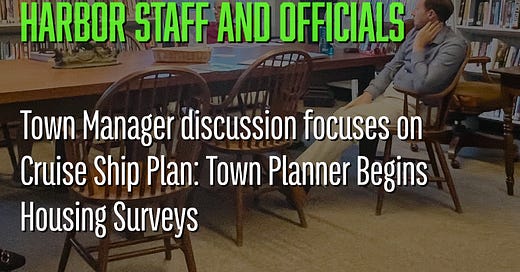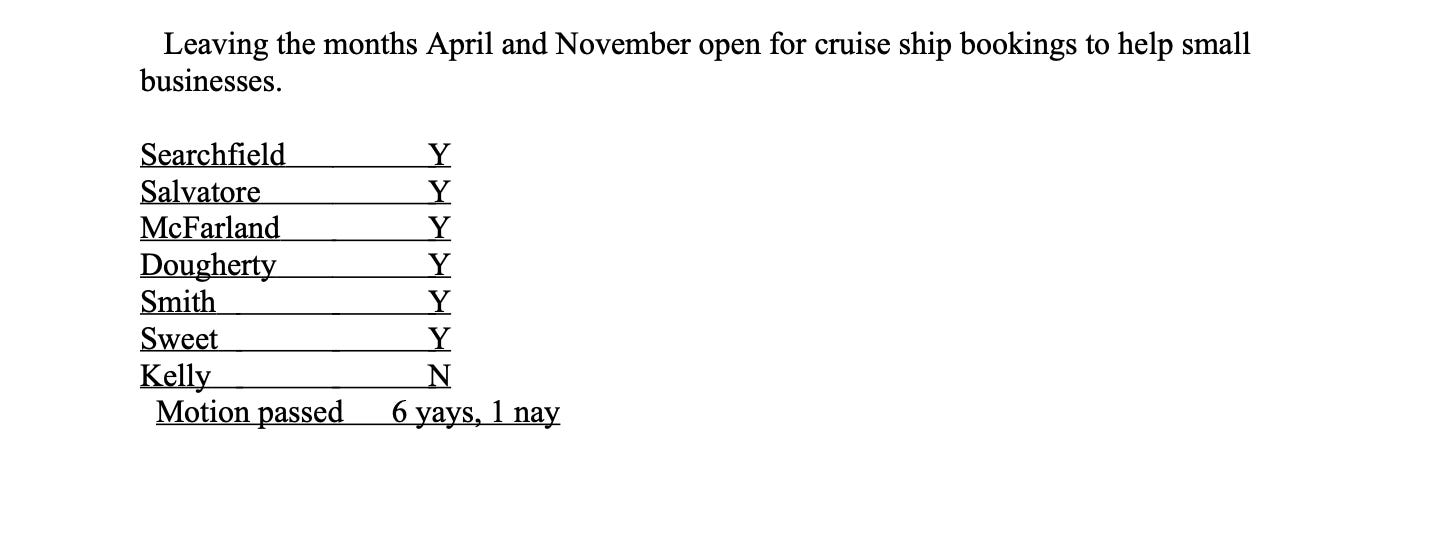New Town Manager Minutes Opens Access to Top Bar Harbor Staff and Officials
Town Manager discussion focuses on Cruise Ship Plan: Town Planner Begins Housing Surveys
BAR HARBOR—Town Manager Kevin Sutherland and Town Councilor Jill Goldthwait spoke with four members of the community during the new Manager Minutes open discussions that will be occurring Wednesdays throughout the fall. The first occurred at the Jesup Memorial Library’s periodicals room and focused mostly on the town’s cruise ship management plan and then morphed into a discussion of Bar Harbor as a tourism community and short-term rentals
Warrant Committee and Cruise Ship Committee member Eben Salvatore was there for the first part of the meeting and the town’s new communication’s coordinator Maya Caines. Originally only two members of the public was attending, but three more joined in shortly before five.
General Discussion of Cruise Ship Management Plan
One of the members of public initially in attendance said that the cruise ship discussion is “one of the most complex things I’ve ever followed in this town.”
Sutherland and Goldthwait quickly explained that the cruise ship management plan created by a working group has created a memorandum of agreement that would hold cruise lines accountable for two years. And that in 2023 (next year), they’ll be negotiating about the 2025 season.
Sutherland said that change is slow and steady when dealing with the industry, but that he hopes that over time the industry’s agreements with Bar Harbor will help push the industry to building and sending smaller cruise ships into the region. The duo said that the clear message from the cruise ship survey that the town sent out was that people wanted to find a way to stop bringing in the large ships. They believe this plan begins that process. In that same 2021 survey, 55% of those surveyed (1,533 responses) said that cruise ship tourism was more of a negative than a positive; 53% said it negatively impacted residents’ quality of life; 55% said that it detracts from the overall image of Bar Harbor and the three greatest challenges were foot traffic, too many ships, and environmental concerns. Just under half of the respondents said that the economic impacts of tourism and fees the town collect were important.
Sutherland added that federal antitrust laws help to make limiting cruise ships difficult and legally treacherous.
Goldthwait used a railroad metaphor to explain it, asking the member of the public to imagine that they were going to build a railroad across multiple states and that each state had a different set of rules and stipulations. It would be impossible to build that railroad. Cruise ships, she said, are in that same situation because they can’t comply with multiple sets of regulations from different courts. She said the town would be at an extreme disadvantage were they to go to court over cruise ship restrictions and would put Bar Harbor tax payers at risk, which is one of the reasons that the town decided to create a plan that limits cruise ships in cooperation with the industry.
The cruise ship management plan uses lower berth capacities to determine the amount of cruise ships allowed in Bar Harbor each month. Already there have been 27 ships turned away for next season based on that plan for a combined lower birth capacity of approximately 39,000. Lower berth capacities correlate directly with the size of the ship. The larger the ship, generally the larger the lower berth capacity number.
Town voters also have an opportunity to approve or vote down another mechanism to limit cruise ship passengers in Bar Harbor. A citizens petition will be before voters in November. That petition is not a compromise with the industry and instead focuses on daily passenger disembarkations, topping them at 1,000 a day.
During the discussion, audience members worried about the pollution of cruise ships. Goldthwait said that there is no documentation that the cruise ships are polluting the waters of Bar Harbor and the documentation actually shows the opposite.
Sutherland said that the agreements between the town and the cruise lines can be adjusted after the season and when the town sees what went well and what didn’t. Then, he said, the community would determine what changes community members want and they would go back to the cruise lines with potentially amended agreements. Prior to the cruise ship management plan, the town has standard operating procedures that each cruise line acknowledges receiving prior to the start of the season. The MOA further solidifies those.
Sutherland added that the town can’t stop people from going off ships any more than it could put a gate at the head of the island. He believes there will be a lawsuit against the town if the petition passes.
In 2019 before the COVID-19 pandemic, there were about 170 visits and an estimated 270,000 passengers who disembarked during the multi-month season. In 2021, Acadia National Park had 4 million visits though cruise ships were not allowed that year.
The recently approved town plan would ban cruise ship visits in April and November as well as have a cap of 3,800 in September and October. The current daily cap is 5,500 for those months. The new plan would allow no more than three cruise ships each day. During July and August the monthly limit would be 40,000. That limit would be 65,000 in September and October. The limit in May and June would be 30,000.
Lower Berthing Capacity
The discussion also delved into lower berthing capacity, which is what the town’s plan depends on. Opponents of using lower berthing capacity say it’s a theoretical number. It’s a number based on double occupancy of rooms on the ship. In some cases there may be only one guest in a room. In some cases there might be a child or additional person in the room that would be on a cot or similar sleeping place (upper berth).
However, Goldthwait said the frequency of usage of upper berths is low. Salvatore said it’s rare for ship disembarkations to be above the lower berth capacity number.
The “Economic Impact of Cruise Ship Passengers Visiting Bar Harbor” (2016) and the “Survey of Maine Cruise Visitors to Maine” have that disembarkation rate at 85%. Those numbers do not consider ships canceling or ships not fully booked. Salvatore said at the discussion that employees were also counted in that survey.
A 2017 survey from the data collected by the harbormaster showed that 59% of ships in 2017 were not fully booked. Another study from 2019 showed that ships that year were 94% occupied.
Ocean Properties, Salvatore said, does have daily counts as do the tenders and ship captains.
Shoulder Seasons and Cruise Ship Committee
The sole member of the public who was not on a town board or official also asked about the cruise ship committee votes that said that they didn’t recommend a plan. None of those attending remembered those votes, however, there were two votes at an August meeting (below) where the committee sent specific recommendations to the town council. During the summer Sutherland asked for community members to give him feedback about the plan. He then shared that feedback with council.
One of those worries for the Cruise Ship Committee (which is not the same group as those tasked with creating the cruise ship management plan) was not allowing cruise ships on the shoulder seasons. At this week’s discussion, Salvatore said that 13,000 passengers came to Bar Harbor without issue. Goldthwait stressed that for public works it can be a logistical issue because the department is doing winter clean up or preparing for winter.
HOUSING SURVEYS
Also this week, the town sent out two separate surveys to assess the housing needs for workers and employers.
A press release from Planning Director Michele Gagnon reads,
“The Town of Bar Harbor wants to hear from community. It specifically wants to hear from area residents who work, or would like to work, in Bar Harbor but for whom availability and affordability presents a challenge. Data is needed to help drive future decision-making.
“To get this information, the town is launching two separate surveys. The Housing Survey for Area Workers is designed for people working in the region, not just in Bar Harbor. It seeks to understand the housing preferences people have, and the choices they make. If they were able to live and work in Bar Harbor, would they choose to do so and under what conditions?”
That survey is seeking to gather information from people not located in Bar Harbor, but who travel to Bar Harbor to work.
The second survey is the Housing Survey for Employers, Gagnon wrote “is specifically designed for Bar Harbor-based employers and seeks to get information on employment, employment by type (year-round vs. seasonal), salary range, current housing portfolio, estimates of housing needs and more.”
The release also states the goal of surveying the community is to allow the town to “understand how well the local housing stock meets the demand of current and future residents in terms of housing quality and suitability.” It is part of the Town Council’s 10-Point Housing Policy Framework adopted in 2019.
To Learn More About Some of The Things Discussed Here
https://www.statista.com/statistics/270649/lower-berths-of-the-north-american-cruise-industry/
Town water quality studies from 2004-2018 http://www.barharbormaine.gov/387/Water-Quality-Studies
Cruise Ship Tourism and Traffic Congestion Report (2019)
Bar Harbor Town Council Signs Agreement Limiting Cruise Ship Visits
For More Information on the Housing Surveys
Contact: Planning Director Michele Gagnon, planner@barharbormaine.gov / (207) 288-1789
The deadline for filling out the surveys is Friday, November 11.
The surveys can be completed online or by filling out a paper copy.
Tbar-harbor-me and choose the appropriate survey.
To get a paper copy of either survey, call (207) 288-3329, email planner@barharbormaine.gov or stop by the Municipal Building (93 Cottage Street in Bar Harbor) and pick up a copy from the table in the main hallway. Paper copies can be returned by mail or in person at that address (there is a large drop box on the table in the hallway).
For more information, contact Planning Director Michele Gagnon by calling (207) 288-1789 or emailing planner@barharbormaine.gov.









